Examining the US Dollar's Influence and Potential Challenges Ahead
VerifiedAdded on 2023/06/04
|9
|2593
|422
Essay
AI Summary
This essay explores the historical and current dominance of the US dollar as the world's leading currency. It discusses the factors contributing to its strength, including the backing of the American economy, its widespread acceptance in international trade and finance, and the influence of US economic policies. The essay also considers potential challenges to the dollar's hegemony, such as the rise of the Euro and the Chinese Yuan, as well as the impact of political and economic policies. It concludes that despite these challenges, the US dollar remains a powerful currency due to its liquidity, the size and efficiency of the US financial markets, and the lack of viable alternatives.
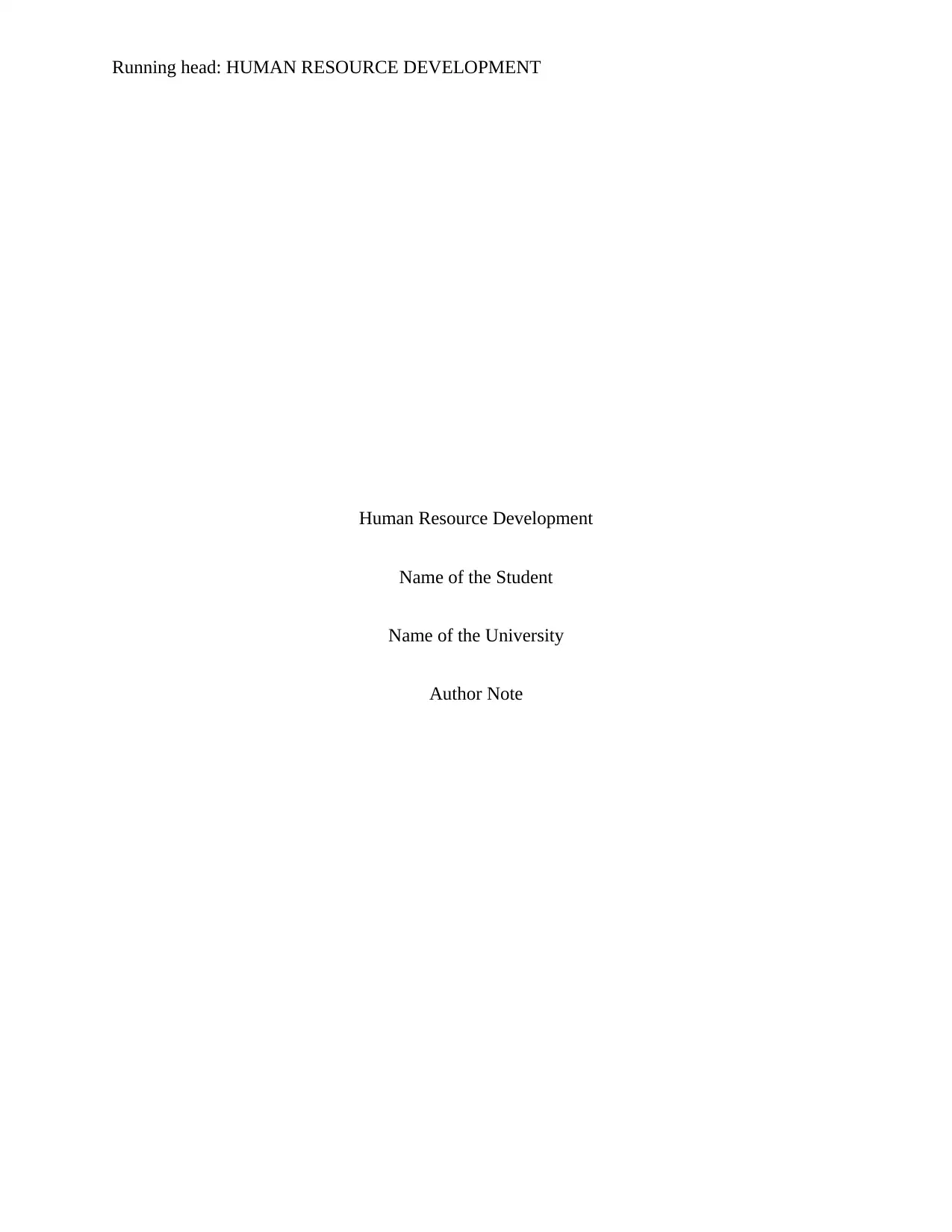
Running head: HUMAN RESOURCE DEVELOPMENT
Human Resource Development
Name of the Student
Name of the University
Author Note
Human Resource Development
Name of the Student
Name of the University
Author Note
Paraphrase This Document
Need a fresh take? Get an instant paraphrase of this document with our AI Paraphraser
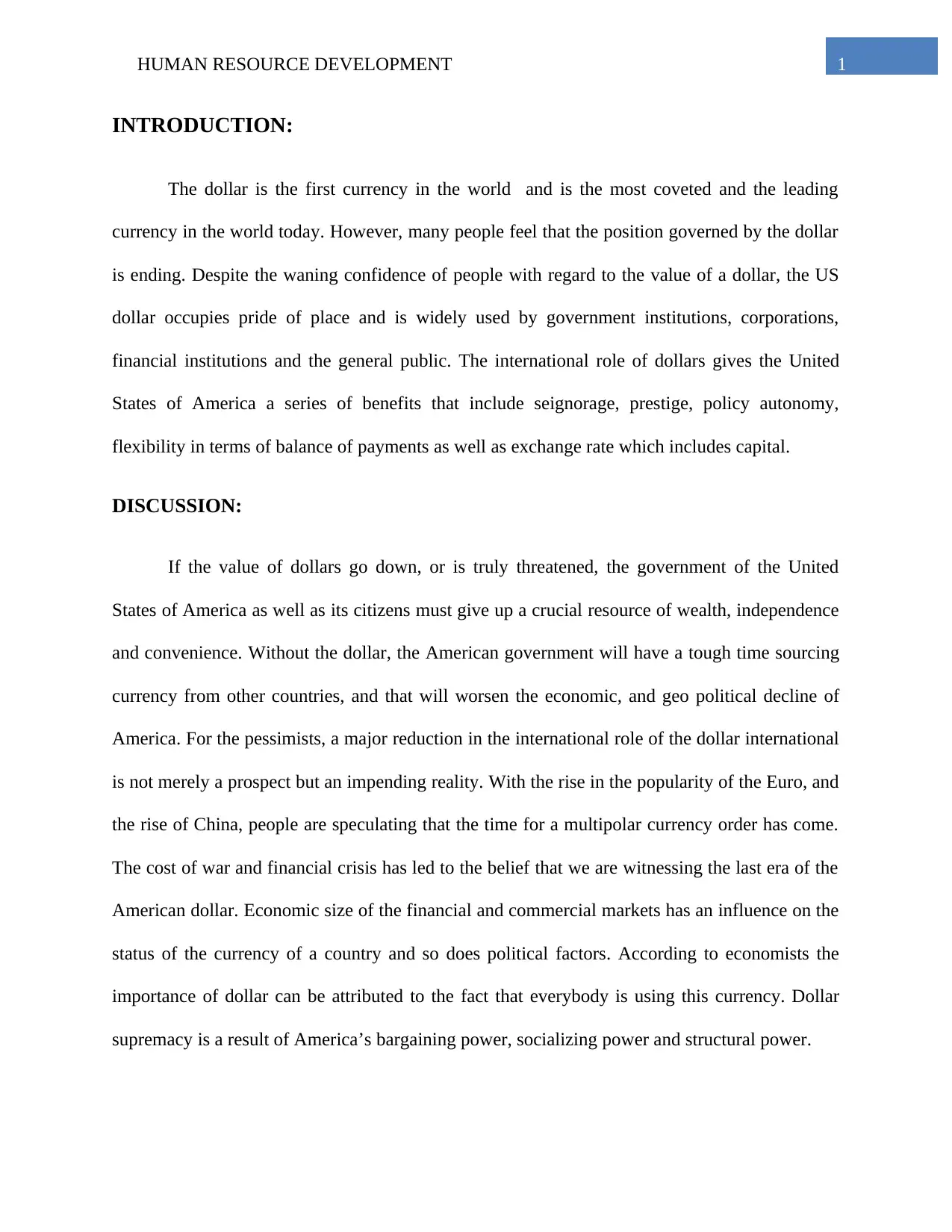
1HUMAN RESOURCE DEVELOPMENT
INTRODUCTION:
The dollar is the first currency in the world and is the most coveted and the leading
currency in the world today. However, many people feel that the position governed by the dollar
is ending. Despite the waning confidence of people with regard to the value of a dollar, the US
dollar occupies pride of place and is widely used by government institutions, corporations,
financial institutions and the general public. The international role of dollars gives the United
States of America a series of benefits that include seignorage, prestige, policy autonomy,
flexibility in terms of balance of payments as well as exchange rate which includes capital.
DISCUSSION:
If the value of dollars go down, or is truly threatened, the government of the United
States of America as well as its citizens must give up a crucial resource of wealth, independence
and convenience. Without the dollar, the American government will have a tough time sourcing
currency from other countries, and that will worsen the economic, and geo political decline of
America. For the pessimists, a major reduction in the international role of the dollar international
is not merely a prospect but an impending reality. With the rise in the popularity of the Euro, and
the rise of China, people are speculating that the time for a multipolar currency order has come.
The cost of war and financial crisis has led to the belief that we are witnessing the last era of the
American dollar. Economic size of the financial and commercial markets has an influence on the
status of the currency of a country and so does political factors. According to economists the
importance of dollar can be attributed to the fact that everybody is using this currency. Dollar
supremacy is a result of America’s bargaining power, socializing power and structural power.
INTRODUCTION:
The dollar is the first currency in the world and is the most coveted and the leading
currency in the world today. However, many people feel that the position governed by the dollar
is ending. Despite the waning confidence of people with regard to the value of a dollar, the US
dollar occupies pride of place and is widely used by government institutions, corporations,
financial institutions and the general public. The international role of dollars gives the United
States of America a series of benefits that include seignorage, prestige, policy autonomy,
flexibility in terms of balance of payments as well as exchange rate which includes capital.
DISCUSSION:
If the value of dollars go down, or is truly threatened, the government of the United
States of America as well as its citizens must give up a crucial resource of wealth, independence
and convenience. Without the dollar, the American government will have a tough time sourcing
currency from other countries, and that will worsen the economic, and geo political decline of
America. For the pessimists, a major reduction in the international role of the dollar international
is not merely a prospect but an impending reality. With the rise in the popularity of the Euro, and
the rise of China, people are speculating that the time for a multipolar currency order has come.
The cost of war and financial crisis has led to the belief that we are witnessing the last era of the
American dollar. Economic size of the financial and commercial markets has an influence on the
status of the currency of a country and so does political factors. According to economists the
importance of dollar can be attributed to the fact that everybody is using this currency. Dollar
supremacy is a result of America’s bargaining power, socializing power and structural power.
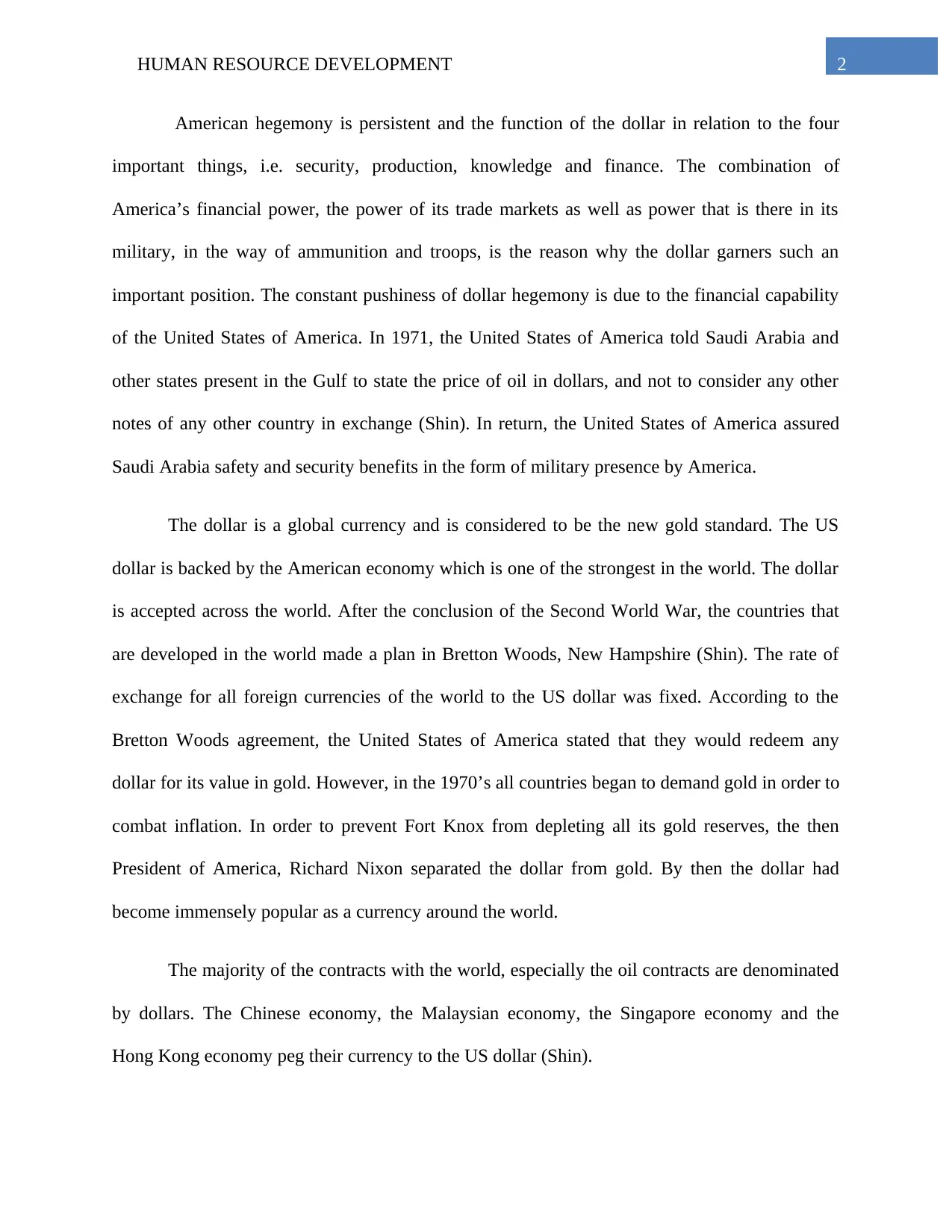
2HUMAN RESOURCE DEVELOPMENT
American hegemony is persistent and the function of the dollar in relation to the four
important things, i.e. security, production, knowledge and finance. The combination of
America’s financial power, the power of its trade markets as well as power that is there in its
military, in the way of ammunition and troops, is the reason why the dollar garners such an
important position. The constant pushiness of dollar hegemony is due to the financial capability
of the United States of America. In 1971, the United States of America told Saudi Arabia and
other states present in the Gulf to state the price of oil in dollars, and not to consider any other
notes of any other country in exchange (Shin). In return, the United States of America assured
Saudi Arabia safety and security benefits in the form of military presence by America.
The dollar is a global currency and is considered to be the new gold standard. The US
dollar is backed by the American economy which is one of the strongest in the world. The dollar
is accepted across the world. After the conclusion of the Second World War, the countries that
are developed in the world made a plan in Bretton Woods, New Hampshire (Shin). The rate of
exchange for all foreign currencies of the world to the US dollar was fixed. According to the
Bretton Woods agreement, the United States of America stated that they would redeem any
dollar for its value in gold. However, in the 1970’s all countries began to demand gold in order to
combat inflation. In order to prevent Fort Knox from depleting all its gold reserves, the then
President of America, Richard Nixon separated the dollar from gold. By then the dollar had
become immensely popular as a currency around the world.
The majority of the contracts with the world, especially the oil contracts are denominated
by dollars. The Chinese economy, the Malaysian economy, the Singapore economy and the
Hong Kong economy peg their currency to the US dollar (Shin).
American hegemony is persistent and the function of the dollar in relation to the four
important things, i.e. security, production, knowledge and finance. The combination of
America’s financial power, the power of its trade markets as well as power that is there in its
military, in the way of ammunition and troops, is the reason why the dollar garners such an
important position. The constant pushiness of dollar hegemony is due to the financial capability
of the United States of America. In 1971, the United States of America told Saudi Arabia and
other states present in the Gulf to state the price of oil in dollars, and not to consider any other
notes of any other country in exchange (Shin). In return, the United States of America assured
Saudi Arabia safety and security benefits in the form of military presence by America.
The dollar is a global currency and is considered to be the new gold standard. The US
dollar is backed by the American economy which is one of the strongest in the world. The dollar
is accepted across the world. After the conclusion of the Second World War, the countries that
are developed in the world made a plan in Bretton Woods, New Hampshire (Shin). The rate of
exchange for all foreign currencies of the world to the US dollar was fixed. According to the
Bretton Woods agreement, the United States of America stated that they would redeem any
dollar for its value in gold. However, in the 1970’s all countries began to demand gold in order to
combat inflation. In order to prevent Fort Knox from depleting all its gold reserves, the then
President of America, Richard Nixon separated the dollar from gold. By then the dollar had
become immensely popular as a currency around the world.
The majority of the contracts with the world, especially the oil contracts are denominated
by dollars. The Chinese economy, the Malaysian economy, the Singapore economy and the
Hong Kong economy peg their currency to the US dollar (Shin).
⊘ This is a preview!⊘
Do you want full access?
Subscribe today to unlock all pages.

Trusted by 1+ million students worldwide
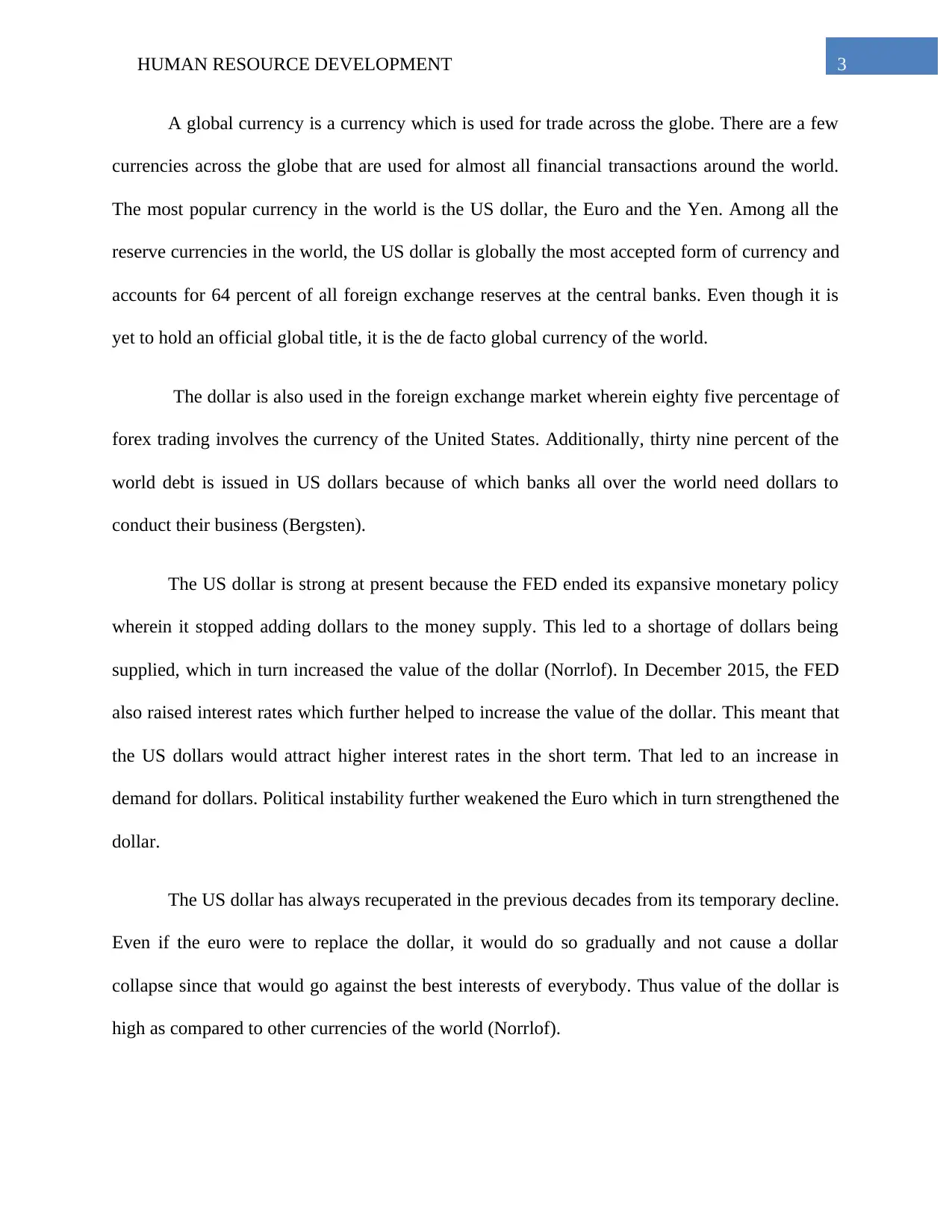
3HUMAN RESOURCE DEVELOPMENT
A global currency is a currency which is used for trade across the globe. There are a few
currencies across the globe that are used for almost all financial transactions around the world.
The most popular currency in the world is the US dollar, the Euro and the Yen. Among all the
reserve currencies in the world, the US dollar is globally the most accepted form of currency and
accounts for 64 percent of all foreign exchange reserves at the central banks. Even though it is
yet to hold an official global title, it is the de facto global currency of the world.
The dollar is also used in the foreign exchange market wherein eighty five percentage of
forex trading involves the currency of the United States. Additionally, thirty nine percent of the
world debt is issued in US dollars because of which banks all over the world need dollars to
conduct their business (Bergsten).
The US dollar is strong at present because the FED ended its expansive monetary policy
wherein it stopped adding dollars to the money supply. This led to a shortage of dollars being
supplied, which in turn increased the value of the dollar (Norrlof). In December 2015, the FED
also raised interest rates which further helped to increase the value of the dollar. This meant that
the US dollars would attract higher interest rates in the short term. That led to an increase in
demand for dollars. Political instability further weakened the Euro which in turn strengthened the
dollar.
The US dollar has always recuperated in the previous decades from its temporary decline.
Even if the euro were to replace the dollar, it would do so gradually and not cause a dollar
collapse since that would go against the best interests of everybody. Thus value of the dollar is
high as compared to other currencies of the world (Norrlof).
A global currency is a currency which is used for trade across the globe. There are a few
currencies across the globe that are used for almost all financial transactions around the world.
The most popular currency in the world is the US dollar, the Euro and the Yen. Among all the
reserve currencies in the world, the US dollar is globally the most accepted form of currency and
accounts for 64 percent of all foreign exchange reserves at the central banks. Even though it is
yet to hold an official global title, it is the de facto global currency of the world.
The dollar is also used in the foreign exchange market wherein eighty five percentage of
forex trading involves the currency of the United States. Additionally, thirty nine percent of the
world debt is issued in US dollars because of which banks all over the world need dollars to
conduct their business (Bergsten).
The US dollar is strong at present because the FED ended its expansive monetary policy
wherein it stopped adding dollars to the money supply. This led to a shortage of dollars being
supplied, which in turn increased the value of the dollar (Norrlof). In December 2015, the FED
also raised interest rates which further helped to increase the value of the dollar. This meant that
the US dollars would attract higher interest rates in the short term. That led to an increase in
demand for dollars. Political instability further weakened the Euro which in turn strengthened the
dollar.
The US dollar has always recuperated in the previous decades from its temporary decline.
Even if the euro were to replace the dollar, it would do so gradually and not cause a dollar
collapse since that would go against the best interests of everybody. Thus value of the dollar is
high as compared to other currencies of the world (Norrlof).
Paraphrase This Document
Need a fresh take? Get an instant paraphrase of this document with our AI Paraphraser
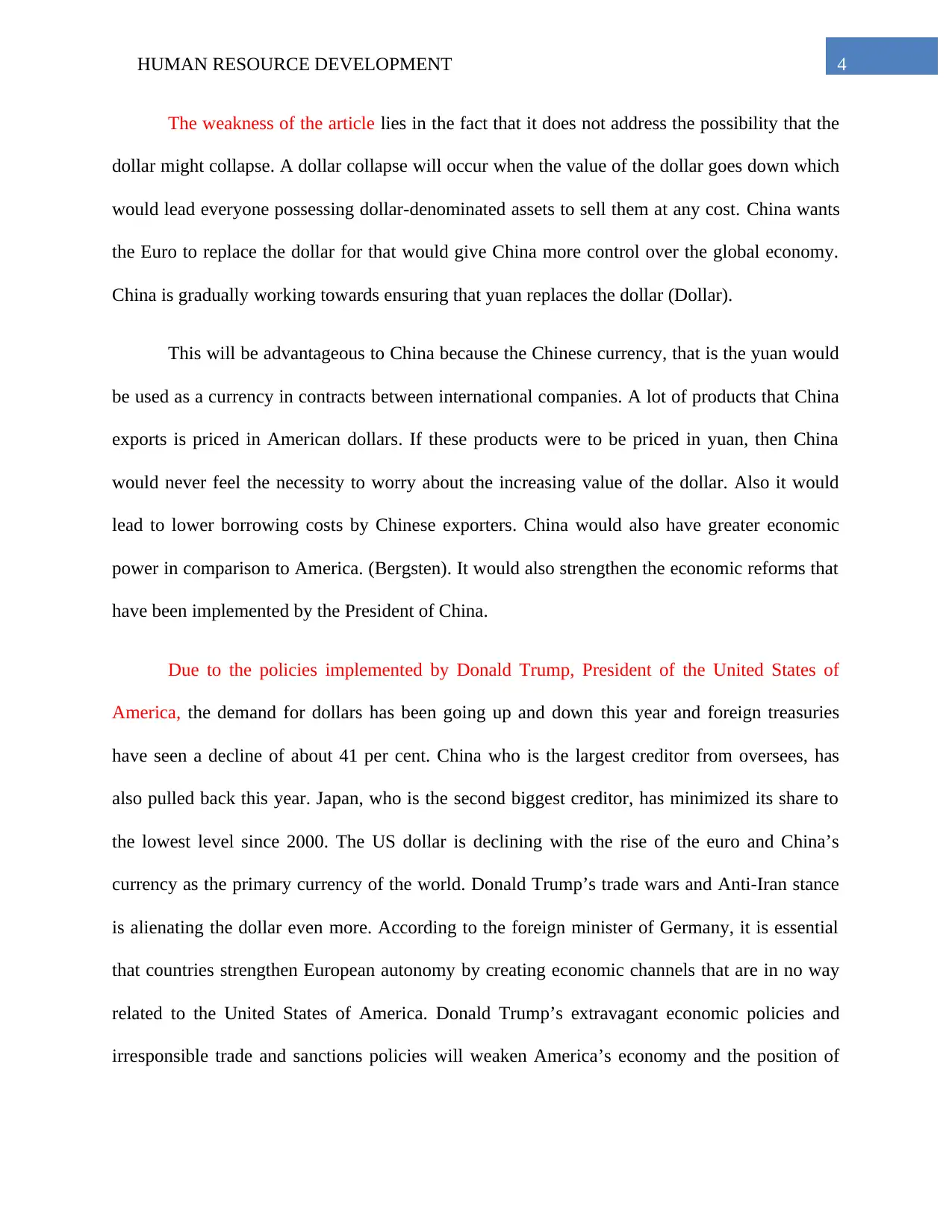
4HUMAN RESOURCE DEVELOPMENT
The weakness of the article lies in the fact that it does not address the possibility that the
dollar might collapse. A dollar collapse will occur when the value of the dollar goes down which
would lead everyone possessing dollar-denominated assets to sell them at any cost. China wants
the Euro to replace the dollar for that would give China more control over the global economy.
China is gradually working towards ensuring that yuan replaces the dollar (Dollar).
This will be advantageous to China because the Chinese currency, that is the yuan would
be used as a currency in contracts between international companies. A lot of products that China
exports is priced in American dollars. If these products were to be priced in yuan, then China
would never feel the necessity to worry about the increasing value of the dollar. Also it would
lead to lower borrowing costs by Chinese exporters. China would also have greater economic
power in comparison to America. (Bergsten). It would also strengthen the economic reforms that
have been implemented by the President of China.
Due to the policies implemented by Donald Trump, President of the United States of
America, the demand for dollars has been going up and down this year and foreign treasuries
have seen a decline of about 41 per cent. China who is the largest creditor from oversees, has
also pulled back this year. Japan, who is the second biggest creditor, has minimized its share to
the lowest level since 2000. The US dollar is declining with the rise of the euro and China’s
currency as the primary currency of the world. Donald Trump’s trade wars and Anti-Iran stance
is alienating the dollar even more. According to the foreign minister of Germany, it is essential
that countries strengthen European autonomy by creating economic channels that are in no way
related to the United States of America. Donald Trump’s extravagant economic policies and
irresponsible trade and sanctions policies will weaken America’s economy and the position of
The weakness of the article lies in the fact that it does not address the possibility that the
dollar might collapse. A dollar collapse will occur when the value of the dollar goes down which
would lead everyone possessing dollar-denominated assets to sell them at any cost. China wants
the Euro to replace the dollar for that would give China more control over the global economy.
China is gradually working towards ensuring that yuan replaces the dollar (Dollar).
This will be advantageous to China because the Chinese currency, that is the yuan would
be used as a currency in contracts between international companies. A lot of products that China
exports is priced in American dollars. If these products were to be priced in yuan, then China
would never feel the necessity to worry about the increasing value of the dollar. Also it would
lead to lower borrowing costs by Chinese exporters. China would also have greater economic
power in comparison to America. (Bergsten). It would also strengthen the economic reforms that
have been implemented by the President of China.
Due to the policies implemented by Donald Trump, President of the United States of
America, the demand for dollars has been going up and down this year and foreign treasuries
have seen a decline of about 41 per cent. China who is the largest creditor from oversees, has
also pulled back this year. Japan, who is the second biggest creditor, has minimized its share to
the lowest level since 2000. The US dollar is declining with the rise of the euro and China’s
currency as the primary currency of the world. Donald Trump’s trade wars and Anti-Iran stance
is alienating the dollar even more. According to the foreign minister of Germany, it is essential
that countries strengthen European autonomy by creating economic channels that are in no way
related to the United States of America. Donald Trump’s extravagant economic policies and
irresponsible trade and sanctions policies will weaken America’s economy and the position of
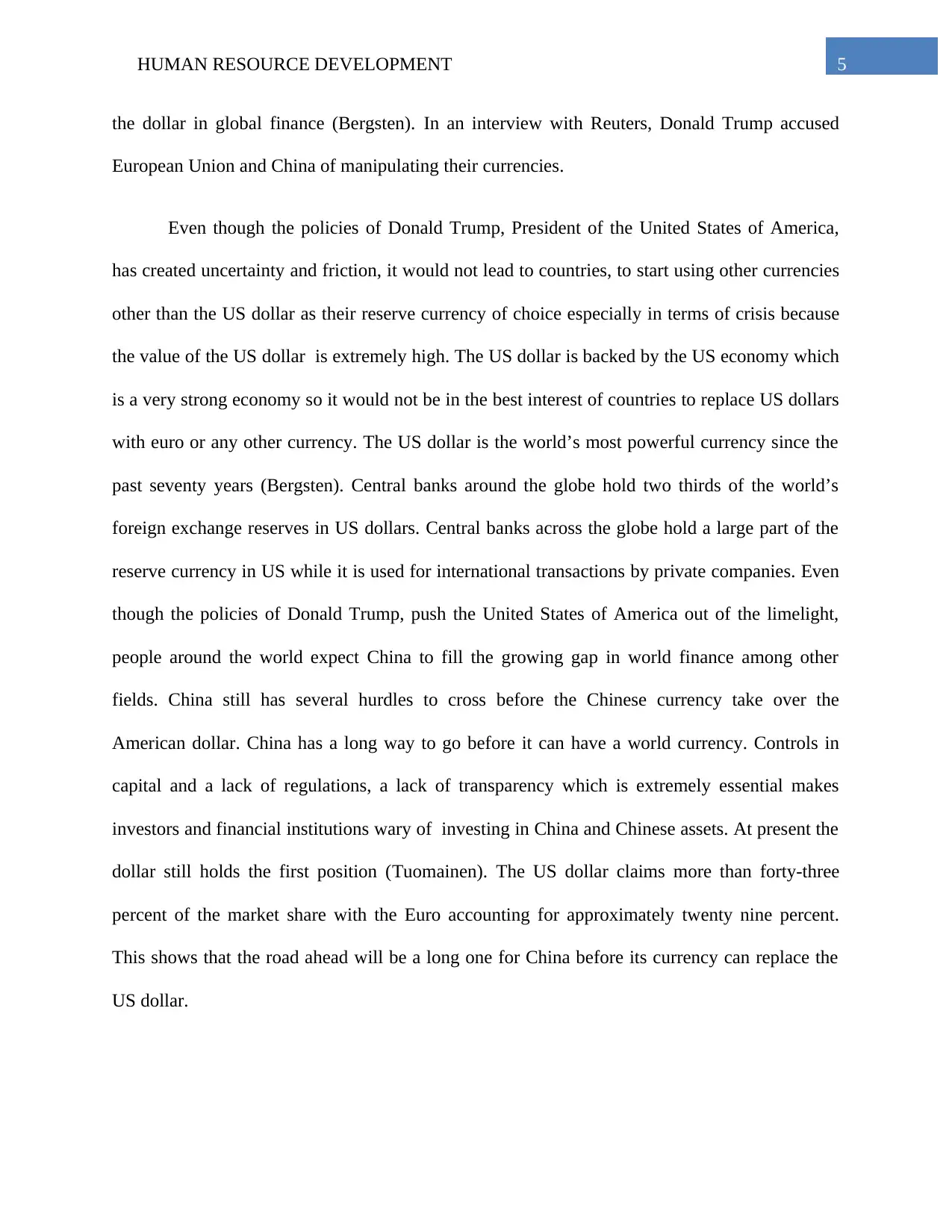
5HUMAN RESOURCE DEVELOPMENT
the dollar in global finance (Bergsten). In an interview with Reuters, Donald Trump accused
European Union and China of manipulating their currencies.
Even though the policies of Donald Trump, President of the United States of America,
has created uncertainty and friction, it would not lead to countries, to start using other currencies
other than the US dollar as their reserve currency of choice especially in terms of crisis because
the value of the US dollar is extremely high. The US dollar is backed by the US economy which
is a very strong economy so it would not be in the best interest of countries to replace US dollars
with euro or any other currency. The US dollar is the world’s most powerful currency since the
past seventy years (Bergsten). Central banks around the globe hold two thirds of the world’s
foreign exchange reserves in US dollars. Central banks across the globe hold a large part of the
reserve currency in US while it is used for international transactions by private companies. Even
though the policies of Donald Trump, push the United States of America out of the limelight,
people around the world expect China to fill the growing gap in world finance among other
fields. China still has several hurdles to cross before the Chinese currency take over the
American dollar. China has a long way to go before it can have a world currency. Controls in
capital and a lack of regulations, a lack of transparency which is extremely essential makes
investors and financial institutions wary of investing in China and Chinese assets. At present the
dollar still holds the first position (Tuomainen). The US dollar claims more than forty-three
percent of the market share with the Euro accounting for approximately twenty nine percent.
This shows that the road ahead will be a long one for China before its currency can replace the
US dollar.
the dollar in global finance (Bergsten). In an interview with Reuters, Donald Trump accused
European Union and China of manipulating their currencies.
Even though the policies of Donald Trump, President of the United States of America,
has created uncertainty and friction, it would not lead to countries, to start using other currencies
other than the US dollar as their reserve currency of choice especially in terms of crisis because
the value of the US dollar is extremely high. The US dollar is backed by the US economy which
is a very strong economy so it would not be in the best interest of countries to replace US dollars
with euro or any other currency. The US dollar is the world’s most powerful currency since the
past seventy years (Bergsten). Central banks around the globe hold two thirds of the world’s
foreign exchange reserves in US dollars. Central banks across the globe hold a large part of the
reserve currency in US while it is used for international transactions by private companies. Even
though the policies of Donald Trump, push the United States of America out of the limelight,
people around the world expect China to fill the growing gap in world finance among other
fields. China still has several hurdles to cross before the Chinese currency take over the
American dollar. China has a long way to go before it can have a world currency. Controls in
capital and a lack of regulations, a lack of transparency which is extremely essential makes
investors and financial institutions wary of investing in China and Chinese assets. At present the
dollar still holds the first position (Tuomainen). The US dollar claims more than forty-three
percent of the market share with the Euro accounting for approximately twenty nine percent.
This shows that the road ahead will be a long one for China before its currency can replace the
US dollar.
⊘ This is a preview!⊘
Do you want full access?
Subscribe today to unlock all pages.

Trusted by 1+ million students worldwide
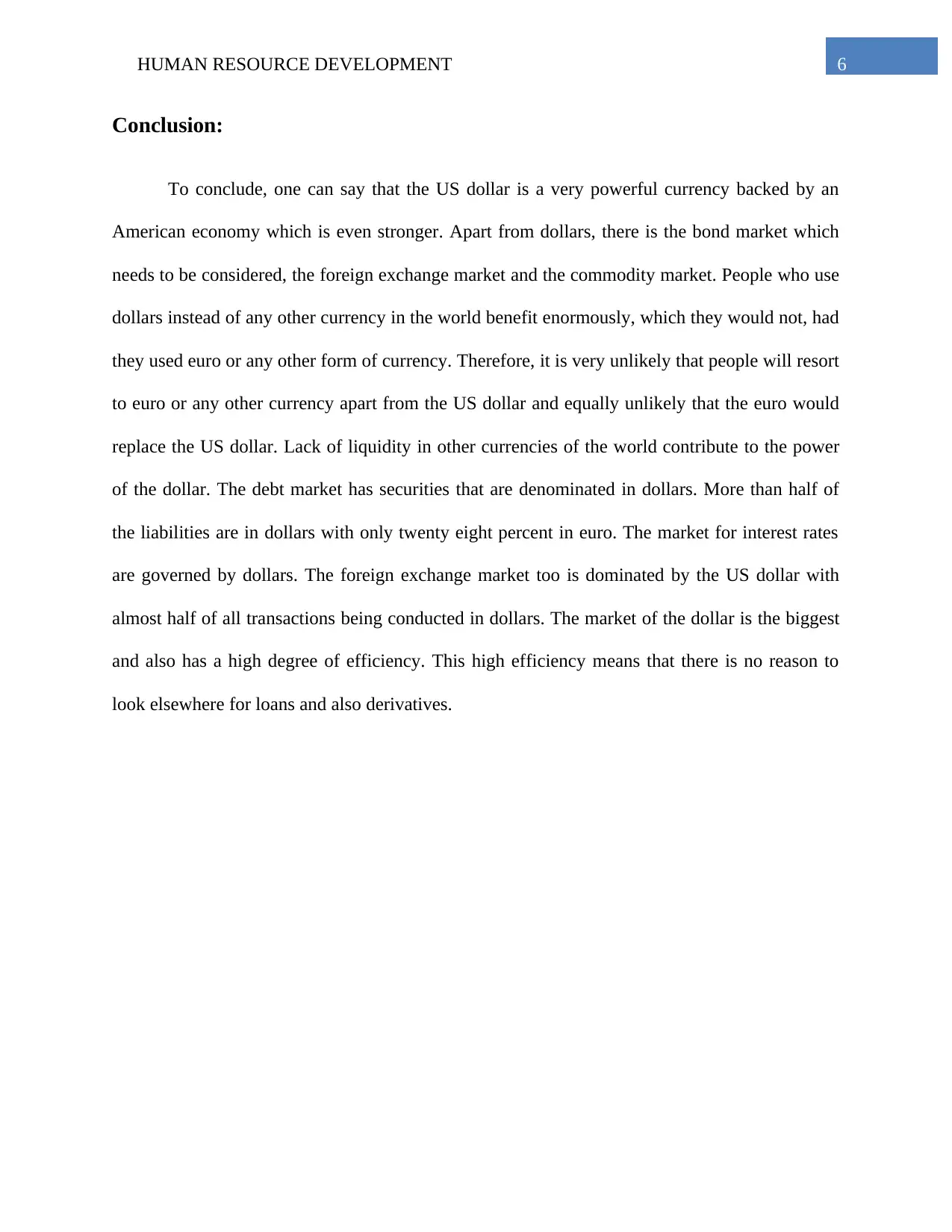
6HUMAN RESOURCE DEVELOPMENT
Conclusion:
To conclude, one can say that the US dollar is a very powerful currency backed by an
American economy which is even stronger. Apart from dollars, there is the bond market which
needs to be considered, the foreign exchange market and the commodity market. People who use
dollars instead of any other currency in the world benefit enormously, which they would not, had
they used euro or any other form of currency. Therefore, it is very unlikely that people will resort
to euro or any other currency apart from the US dollar and equally unlikely that the euro would
replace the US dollar. Lack of liquidity in other currencies of the world contribute to the power
of the dollar. The debt market has securities that are denominated in dollars. More than half of
the liabilities are in dollars with only twenty eight percent in euro. The market for interest rates
are governed by dollars. The foreign exchange market too is dominated by the US dollar with
almost half of all transactions being conducted in dollars. The market of the dollar is the biggest
and also has a high degree of efficiency. This high efficiency means that there is no reason to
look elsewhere for loans and also derivatives.
Conclusion:
To conclude, one can say that the US dollar is a very powerful currency backed by an
American economy which is even stronger. Apart from dollars, there is the bond market which
needs to be considered, the foreign exchange market and the commodity market. People who use
dollars instead of any other currency in the world benefit enormously, which they would not, had
they used euro or any other form of currency. Therefore, it is very unlikely that people will resort
to euro or any other currency apart from the US dollar and equally unlikely that the euro would
replace the US dollar. Lack of liquidity in other currencies of the world contribute to the power
of the dollar. The debt market has securities that are denominated in dollars. More than half of
the liabilities are in dollars with only twenty eight percent in euro. The market for interest rates
are governed by dollars. The foreign exchange market too is dominated by the US dollar with
almost half of all transactions being conducted in dollars. The market of the dollar is the biggest
and also has a high degree of efficiency. This high efficiency means that there is no reason to
look elsewhere for loans and also derivatives.
Paraphrase This Document
Need a fresh take? Get an instant paraphrase of this document with our AI Paraphraser
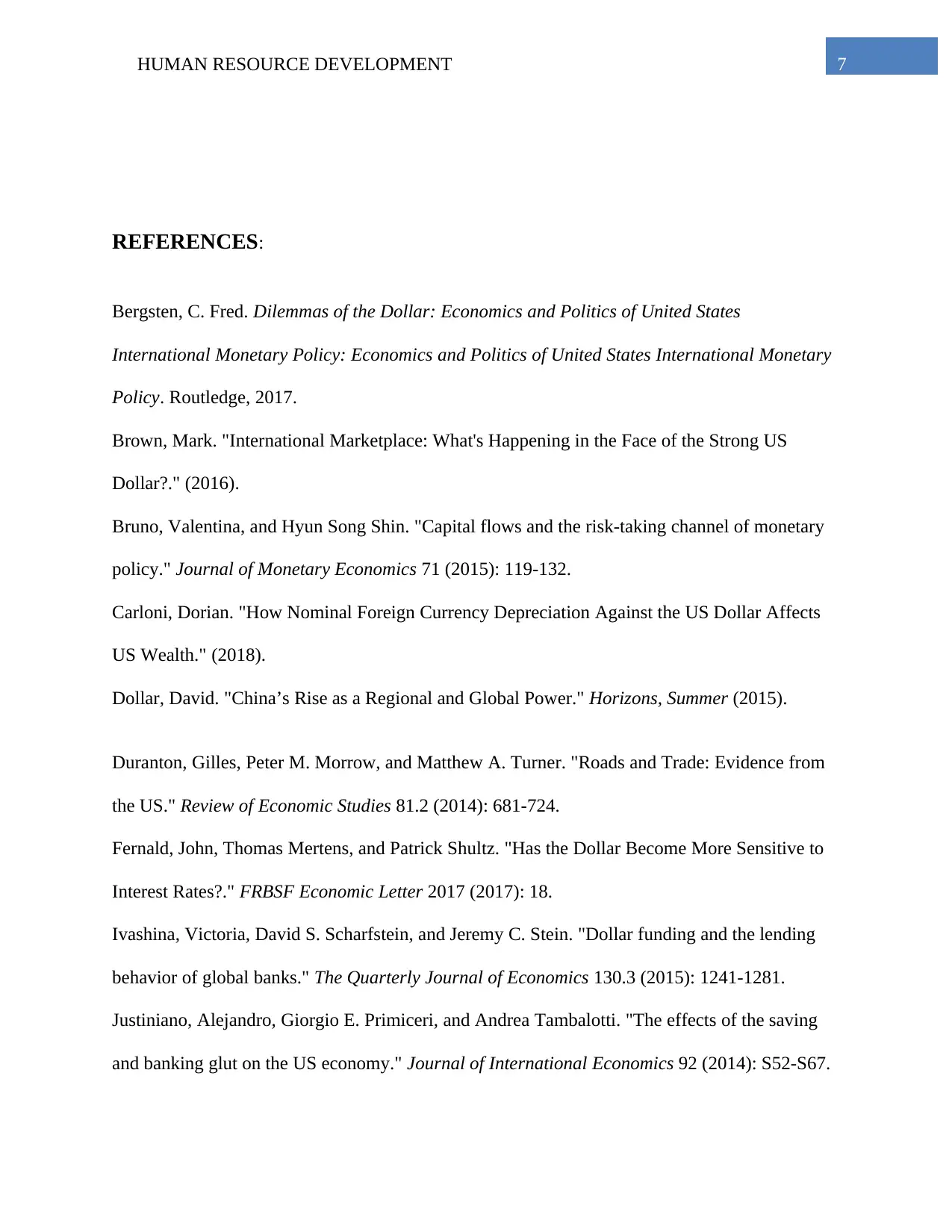
7HUMAN RESOURCE DEVELOPMENT
REFERENCES:
Bergsten, C. Fred. Dilemmas of the Dollar: Economics and Politics of United States
International Monetary Policy: Economics and Politics of United States International Monetary
Policy. Routledge, 2017.
Brown, Mark. "International Marketplace: What's Happening in the Face of the Strong US
Dollar?." (2016).
Bruno, Valentina, and Hyun Song Shin. "Capital flows and the risk-taking channel of monetary
policy." Journal of Monetary Economics 71 (2015): 119-132.
Carloni, Dorian. "How Nominal Foreign Currency Depreciation Against the US Dollar Affects
US Wealth." (2018).
Dollar, David. "China’s Rise as a Regional and Global Power." Horizons, Summer (2015).
Duranton, Gilles, Peter M. Morrow, and Matthew A. Turner. "Roads and Trade: Evidence from
the US." Review of Economic Studies 81.2 (2014): 681-724.
Fernald, John, Thomas Mertens, and Patrick Shultz. "Has the Dollar Become More Sensitive to
Interest Rates?." FRBSF Economic Letter 2017 (2017): 18.
Ivashina, Victoria, David S. Scharfstein, and Jeremy C. Stein. "Dollar funding and the lending
behavior of global banks." The Quarterly Journal of Economics 130.3 (2015): 1241-1281.
Justiniano, Alejandro, Giorgio E. Primiceri, and Andrea Tambalotti. "The effects of the saving
and banking glut on the US economy." Journal of International Economics 92 (2014): S52-S67.
REFERENCES:
Bergsten, C. Fred. Dilemmas of the Dollar: Economics and Politics of United States
International Monetary Policy: Economics and Politics of United States International Monetary
Policy. Routledge, 2017.
Brown, Mark. "International Marketplace: What's Happening in the Face of the Strong US
Dollar?." (2016).
Bruno, Valentina, and Hyun Song Shin. "Capital flows and the risk-taking channel of monetary
policy." Journal of Monetary Economics 71 (2015): 119-132.
Carloni, Dorian. "How Nominal Foreign Currency Depreciation Against the US Dollar Affects
US Wealth." (2018).
Dollar, David. "China’s Rise as a Regional and Global Power." Horizons, Summer (2015).
Duranton, Gilles, Peter M. Morrow, and Matthew A. Turner. "Roads and Trade: Evidence from
the US." Review of Economic Studies 81.2 (2014): 681-724.
Fernald, John, Thomas Mertens, and Patrick Shultz. "Has the Dollar Become More Sensitive to
Interest Rates?." FRBSF Economic Letter 2017 (2017): 18.
Ivashina, Victoria, David S. Scharfstein, and Jeremy C. Stein. "Dollar funding and the lending
behavior of global banks." The Quarterly Journal of Economics 130.3 (2015): 1241-1281.
Justiniano, Alejandro, Giorgio E. Primiceri, and Andrea Tambalotti. "The effects of the saving
and banking glut on the US economy." Journal of International Economics 92 (2014): S52-S67.
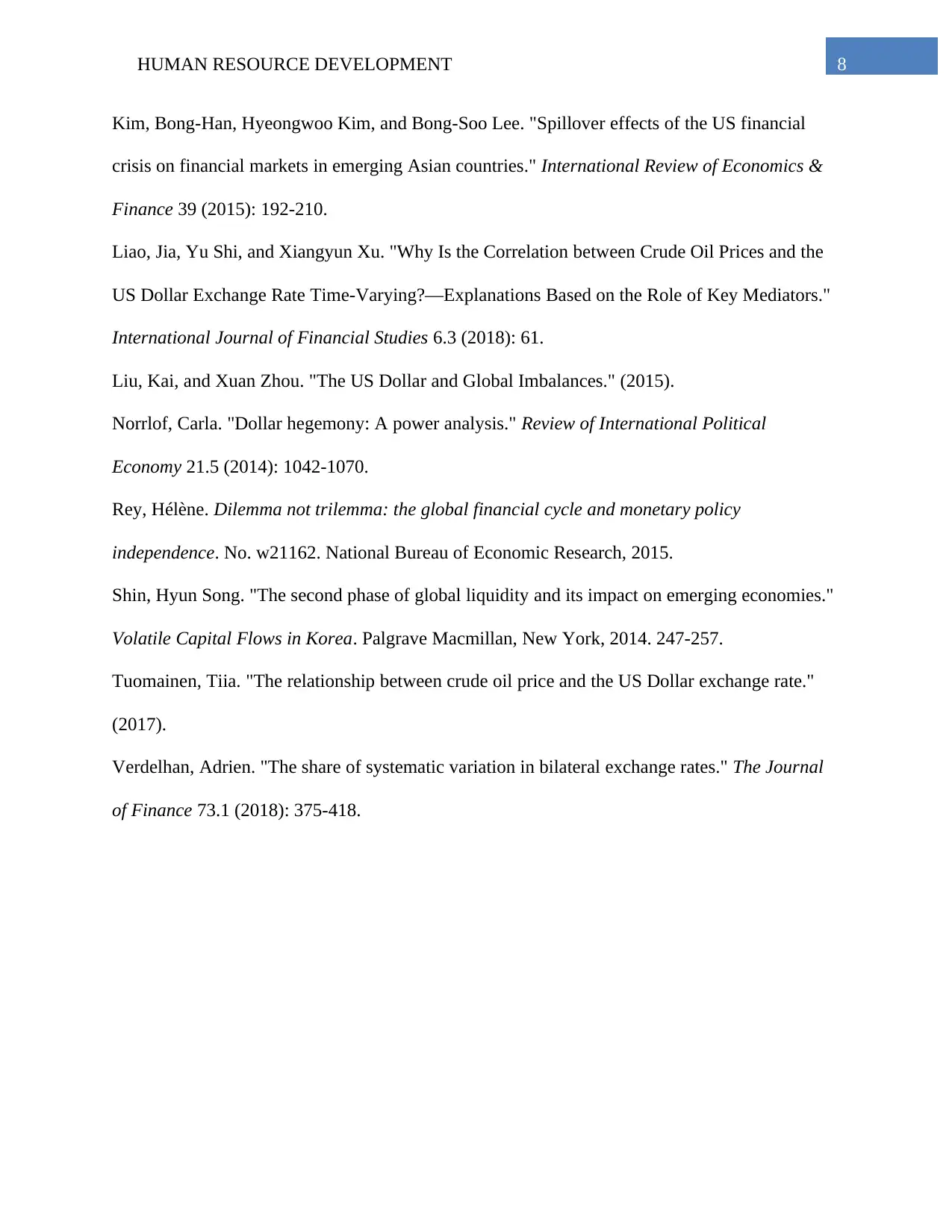
8HUMAN RESOURCE DEVELOPMENT
Kim, Bong-Han, Hyeongwoo Kim, and Bong-Soo Lee. "Spillover effects of the US financial
crisis on financial markets in emerging Asian countries." International Review of Economics &
Finance 39 (2015): 192-210.
Liao, Jia, Yu Shi, and Xiangyun Xu. "Why Is the Correlation between Crude Oil Prices and the
US Dollar Exchange Rate Time-Varying?—Explanations Based on the Role of Key Mediators."
International Journal of Financial Studies 6.3 (2018): 61.
Liu, Kai, and Xuan Zhou. "The US Dollar and Global Imbalances." (2015).
Norrlof, Carla. "Dollar hegemony: A power analysis." Review of International Political
Economy 21.5 (2014): 1042-1070.
Rey, Hélène. Dilemma not trilemma: the global financial cycle and monetary policy
independence. No. w21162. National Bureau of Economic Research, 2015.
Shin, Hyun Song. "The second phase of global liquidity and its impact on emerging economies."
Volatile Capital Flows in Korea. Palgrave Macmillan, New York, 2014. 247-257.
Tuomainen, Tiia. "The relationship between crude oil price and the US Dollar exchange rate."
(2017).
Verdelhan, Adrien. "The share of systematic variation in bilateral exchange rates." The Journal
of Finance 73.1 (2018): 375-418.
Kim, Bong-Han, Hyeongwoo Kim, and Bong-Soo Lee. "Spillover effects of the US financial
crisis on financial markets in emerging Asian countries." International Review of Economics &
Finance 39 (2015): 192-210.
Liao, Jia, Yu Shi, and Xiangyun Xu. "Why Is the Correlation between Crude Oil Prices and the
US Dollar Exchange Rate Time-Varying?—Explanations Based on the Role of Key Mediators."
International Journal of Financial Studies 6.3 (2018): 61.
Liu, Kai, and Xuan Zhou. "The US Dollar and Global Imbalances." (2015).
Norrlof, Carla. "Dollar hegemony: A power analysis." Review of International Political
Economy 21.5 (2014): 1042-1070.
Rey, Hélène. Dilemma not trilemma: the global financial cycle and monetary policy
independence. No. w21162. National Bureau of Economic Research, 2015.
Shin, Hyun Song. "The second phase of global liquidity and its impact on emerging economies."
Volatile Capital Flows in Korea. Palgrave Macmillan, New York, 2014. 247-257.
Tuomainen, Tiia. "The relationship between crude oil price and the US Dollar exchange rate."
(2017).
Verdelhan, Adrien. "The share of systematic variation in bilateral exchange rates." The Journal
of Finance 73.1 (2018): 375-418.
⊘ This is a preview!⊘
Do you want full access?
Subscribe today to unlock all pages.

Trusted by 1+ million students worldwide
1 out of 9
Related Documents
Your All-in-One AI-Powered Toolkit for Academic Success.
+13062052269
info@desklib.com
Available 24*7 on WhatsApp / Email
![[object Object]](/_next/static/media/star-bottom.7253800d.svg)
Unlock your academic potential
Copyright © 2020–2025 A2Z Services. All Rights Reserved. Developed and managed by ZUCOL.





